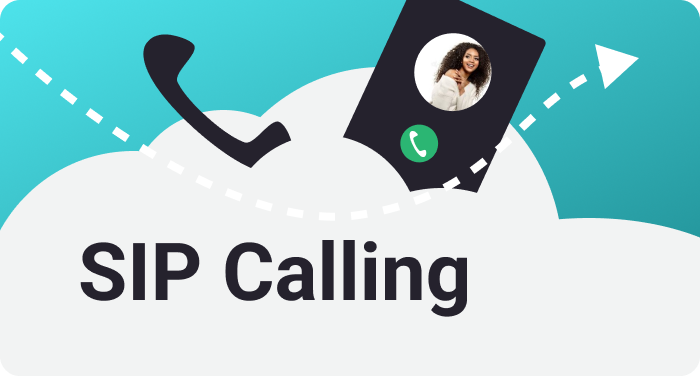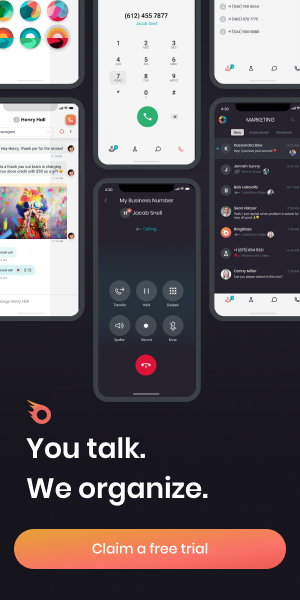Customer support is the foundation of everything. Whether you like it or not, there’s no way around it.
Your company can have the best products, the most skilled employees, the best website UI but it won’t grow as fast as you want it if your customers cannot interact with you smoothly and efficiently.
This is where SIP calling comes into play. A study conducted by Amazon Web Services (AWS) discovered that SIP calling is reliable in 99.9% of all situations. This is just one of the many advantages that this particular phone system can offer you.
Even though the viability of SIP calling is supported by statistics, rave reviews, and lots of positive adjectives, many businesses are still wondering what this technology is and how it works. So, if you’re a bit confused, don’t worry — you’re not the only one.
In this article, we are going to explain all things SIP. So, in the following sections, you will learn:
- What is SIP calling
- The difference between SIP and VoIP
- SIP calling vs. landlines
- How to get started with SIP — what is a SIP account, how to set it up, what you need, etc.
- What features do you get with SIP
- The advantages of SIP
- The disadvantages of SIP
- What does your business gain from SIP
Don’t let the long list discourage you. SIP is a broad topic, but it gets significantly easier once you master the basics. Ready?
What Is SIP Calling?
Session Initiation Protocol, better known as SIP, is a special kind of signaling protocol designed to control communication sessions. These sessions can be over VoIP (Voice over Internet Protocol) or some other platforms, which are usually online or cloud-based. SIP is just one method of deploying VoIP; its primary benefit is the fact that it provides a direct connection between private or local telephone systems and the public telephone network. This way, individuals and businesses don’t need a legacy telephone line in order to connect.
A common mistake is that SIP calling is the only way to use SIP. Believe it or not, your business can also use this technology for things such as video conferencing, instant messaging, and even more complex tasks, like games or augmented reality (AR).

What is the Difference Between SIP and VoIP?
Oftentimes, people tend to confuse these two terms. It makes a lot of confusion and uncertainty when businesses are looking to upgrade their customer support. So, what sets these two terms apart?
Voice over IP (VoIP) is more of an umbrella term that is used to describe phone calls made using the internet instead of an old school phone line. VoIP services connect two or more parties by sending small packets of data, which are decoded into voice files by everyone else participating in the call.
This technology was created in the 1970s and was mostly an afterthought until the last 10-15 years. Companies became interested in VoIP, as it proved to be a viable means of eliminating excess hardware.
Instead of messing with countless landlines, business owners can get a VoIP number and direct their customer support efforts from a single device — a computer or a smartphone.
Unlike VoIP, SIP isn’t a service — it’s merely a protocol that’s used to maintain online communications. As such, SIP can be used within VoIP. You can integrate these two systems, but it’s not a requirement.
It’s also worth mentioning that not all VoIP systems include SIP calling. There are other protocols on the market, but SIP is considered by far the best option. The first thing worth noting is that it is better than landlines.
SIP Calling vs. Landlines
Landlines involve a lot of installation-related work, hardware, wires, and other kinds of troubles that just have no place in the 2020s.
SIP calling is much easier to set up than a landline. All you need to do is contact the telecommunications company you’ve signed a contract with and ask them to reroute your calls to a Public Switched Telephone Network (PSTN). You can also apply for a free SIP number and use a SIP Android client for added portability.
When you create a SIP account, you can make calls by effectively bypassing lines that are used to connect your contact number with the desired destination. The call goes directly to the PSTN, which is a far more reliable option than depending on your telecom provider.
How to Set Up SIP Calling
Ringblaze – the tool we build – is a cloud-based communication tool. Among other things, it allows companies to communicate more efficiently, both internally and with potential customers. One of its core features is voice calling, which removes the need to use a stationary phone at all.
Instead of relying on a landline, you can go completely wireless and have your entire communication history on the cloud.
Let’s talk about SIP address. What is a SIP address you may ask? Well, it’s almost the same as an email address, except it’s used to route all your calls to a single device or location. Besides, you can obtain free SIP addresses from several providers online.
Unlike traditional phone lines, with a Private Branch Exchange and a predetermined number that’s difficult to change, SIP calling also allows you to choose whichever number you like, or even create a custom one.

Source: Freepik
Whether you’re using a computer or a phone, all you need to do is claim your free SIP number and download an app. That’s it!
Also, you should make sure that you have a stable internet connection, and the right equipment needed for SIP calling — headsets, webcams, microphones, etc.
You can start the process anytime you want, without the need to call anyone or seek assistance and also with SIP, there’s no need for a regular, physical connection to a phone company and no need for multiple phone lines.This is what makes SIP calling ideal for small businesses — anyone can set the system up and it doesn’t include any hidden or unnecessary costs.
What Features Do You Get by Setting Up SIP Calling?
Today, with most SIP software, you can do the following:
- Assign calls
- Forward calls to the right customer support agent
- Record calls for later use and analysis
- Add text comments so that the next shift/another team knows precisely what’s going on and how to resolve a problem quickly, without asking other agents for input
- Have people that visit your site call your numbers free from anywhere in the world
- Add the click-to-call link to everything — your blog, email signature, microsites, and much more
- Have multiple phone numbers, based even on different continents, and still answer calls from wherever you want — the office, your home, or even a beach in the Caribbean
Depending on which provider you choose, these features can vary, both in quality and limits.
Once you’ve picked up a free SIP account with your phone number, you can invest more time in optimizing your customer support team and delegating tasks in a much more efficient manner. However, this is just one of the many reasons why SIP calling is the way to go.
What Are the Advantages of SIP Calling?
Perhaps the best part of having a SIP trunk is that you can integrate it with any existing communication software you’re using. SIP calling is seamless and can aid your company in quickly streamlining team-specific tasks. However, that’s just the tip of the iceberg. With a SIP client, you also get:
Real-Time Scalability
No enterprise stagnates. While growth is always welcome, it too comes with its growing pains (pun intended). If your company wants to expand, this expansion should also include your customer support team, right?
When this happens, all the disadvantages of using hardware are revealed. Installation fees, more room for inventory, upkeep, sudden breakdowns, repair fees — all of this can hold back the growth you work so hard for.
Scaling SIP calling is a piece of cake. You can add or remove devices whenever you want, as SIP trunking routes all your communications through a single data connection. The costs are almost nonexistent, and the money you save can be used for other expenses.
Stellar Call Quality, Regardless of the Situation
It is well known that landlines are unreliable. Even a slightly stronger wind can ruin your connection and make it difficult for your customers to interact with you.
SIP calling lets you prepare for even the worst-case scenarios, such as multi-day power outages. Even when you don’t have a working internet connection in your office, calls can still be received by your employees using SIP Android/iOS software. The process is the same, and your customers won’t notice a thing!
Upticks in Productivity
When you have an overview of all your communications on a single dashboard, your employees can carry less of a workload.
Not only are different teams and team leaders able to exchange data in real-time, but they can also save valuable time that would otherwise be spent on managing the means of communication itself.
SIP calling lets your customer support agents focus on resolving the problem, and doing so with a clear mind, without unnecessary pressure. This will directly lead to an improved user experience, especially if your customers are faced with a particular issue.
An Easy-to-Learn System
SIP calling is very easy to learn, even if you haven’t used it before. You can train your staff on how to use it in just a single afternoon. Once they get the basics down, they can activate their accounts immediately — the entire signup process takes just a few minutes.
While we already showed you how SIP calling can make your teams more productive, it’s also worth noting that they will be able to adopt these new habits rather quickly. As a result, your customers will feel the change faster, too.
Minimal Costs Involved
Expanding your landline system involves lots of installation fees. Even the best-case scenario, where everything works perfectly right away, can set you back quite a bit.
SIP calling is cost-effective. Everything relies on your internet connection, so there aren’t any upkeep fees or potential costs that might occur if something goes wrong. You can simply contact your SIP client for free and resolve the issue remotely.
What Are the Disadvantages of SIP Calling?
As amazing as having a SIP account can be, SIP calling also comes with a drawback or two. They are nothing to worry about, but it’s still worth being aware of what you’re in for.
It’s Fairly New
This is a common and, unfortunately, an inevitable problem when it comes to adopting new technologies. SIP calling is a fairly new communication protocol, so you won’t find many people that know how to utilize its full potential.
There will be growing pains at the beginning, but an investment in training your IT staff might be the best way to avoid this SIP-related drawback.
Not Fully Developed for Voice Mail, In-App Features, Gaming and AR
If you’re dealing with the SaaS niche and apps are the foundation of your business, you might find that SIP calling is not that easy to integrate into customer software. While you won’t experience too many issues when integrating a SIP platform into existing programs, it takes some time to understand all the technical nuances.
This also includes AR, advanced features, and gaming. These technologies by themselves are still in development, so it makes sense not to expect them to be tailor-made for SIP calls. In a few years, there will be more integration options.
Conclusion — How Does Your Business Benefit From SIP Calling?
SIP calling allows you to be more accessible to customers, regardless of the location of either party.
If you’re looking to make sales online, simplifying the communication process can lead to some amazing results.
Overall, for communication over the internet, SIP is interesting, with the many features associated with voice and video calls, often involving multiple parties and moreover SIP calling makes life easier for both you and your customers. Without any traditional obstacles in place, you can communicate more freely and make more customers happier. As we all know, happy customers equal returning customers, which, in turn, leads to more sales.
If you don’t want to bother much with a complicated setup – try Ringblaze!
SIP calling: FAQs
SIP is an Internet protocol used for communicating via voice and video calls. That means SIP calls are generally free.
To make a SIP call:
1. Get a SIP Account: Sign up with a SIP provider.
2. Download SIP Software: Install a SIP app or use a SIP-compatible device.
3. Enter Account Info: Input your SIP account details into the software or device settings.
4. Dial Number: Use the SIP app or device keypad to dial the number or SIP address.
5. Make the Call: Tap the call button to initiate the SIP call.
These aren’t competing technologies. SIP (Session Initiation Protocol) is a part of VoIP. It’s a protocol used to manage voice calls.






















